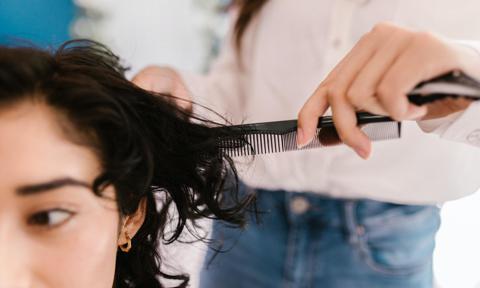
Anyone who’s on a quest to perfect their hair care routine to finally achieve the healthy tresses of their dreams, knows how tricky it is to maintain hair health without trimming it dramatically on the regular. If you’re trying to grow out or even maintain the length of your hair, you’ll inevitably spot split ends and stringy strands at the ends. This is where hair dusting enters the picture.
MORE: Easy-To-Do Rashmika Mandanna Hairstyle
A technique recently resurged by top hair stylist Hollie Rose Clarke, hair dusting essentially helps you get rid of split ends, keep the length and revive your strands to a smoother and healthier-looking state. While it’s best to consult a trusted hair stylist and get the treatment done professionally at a salon, it’s possible to perform it at home by yourself as well.
What is hair dusting?
Hair dusting or surface cutting is a technique of removing split ends and skimpy strands of hair blocking seepage and absorption of moisture to other parts of the hair, with the help of just a pair of scissors. It’s done by snipping the bottom of each strand to eliminate the damaged hair tip. The process begins with your hair being smoothed out, so that rebellious split ends stick up and reveal themselves. This way, when the hairstylist glides their scissors over your hair, the unwanted, exposed tips and stray splits get cut, similar to extracting fuzzy lint from your favourite wool coat.
This hair witchcraft basically gently removes unwanted and unhealthy flyaways without damaging your hair, and sacrificing length or thickness. The only foolproof way to stop split hairs from continuing to split (which leads to progressively shorter and more harmful fly always) is to cut them off.
Does this treatment work for all hair types?
This technique works on all hair types given its non-invasive nature. The only requirement is that the hair needs to be smoothed out so that the rebellious split ends can be visible and trimmed off to perfection.
What are the benefits of hair dusting?
This easy breezy procedure is great for anyone wanting to grow their hair or maintain the length they love. It aims to retain the health of the hair and simply remove the damaged dry ends that cause more harm than good. Since you won’t have to compromise those precious extra inches of your mane, chances are you won’t mind making regular salon appointments, which will result in glass-like shiny, smooth, thicker and fuller hair in the long run.
The best part is that it’s cheaper than an actual cut for starters, and will provide you with a post-cut health boost without losing any length. Hair dusting or micro dusting can also help people who have trouble managing frizz at home.
How to dust your hair at home?
Although it’s always recommended to visit a hair salon to get any beauty treatment done, this process is fairly simple to emulate at home once you get the knack of it. You can even get your first session done at a salon and then maintain the result in between salon visits by dusting the hair at home. All you need is a sharp pair of scissors, which are crucial to achieve precise, clean cuts, a comb, some hair clips, a towel and some good task lighting.
- Wash and blow-dry your hair and part it like you normally would.
- Divide your hair into portions so that you can dust your hair one section at a time.
- Twist or thread each strand of hair between your index and middle finger and back between your ring finger and little finger to get the best view of your stray split ends peeking through.
- When you see a straggly and knackered bit of dead hair or a knot, trim less than a ¼ of an inch from the end of the strand, just enough to cut off the damaged ends.
- Proceed to do this to your whole head of hair and trim any pieces of dry ends you spot. Finish by applying a light serum on your hair ends.
If you’re still not too sure about DIY-ing it, fret not. The internet is flooded with step-by-step video tutorials to help you visualise and execute the technique.
- Quick links
- hair trend
- haircuts
- haircare
- beauty trends







